يونيو 15, 2018 / جامعة جيونج سانج الوطنية, كوريا الجنوبية / مجلة الطب السريري
نص / وو تينغ ياو
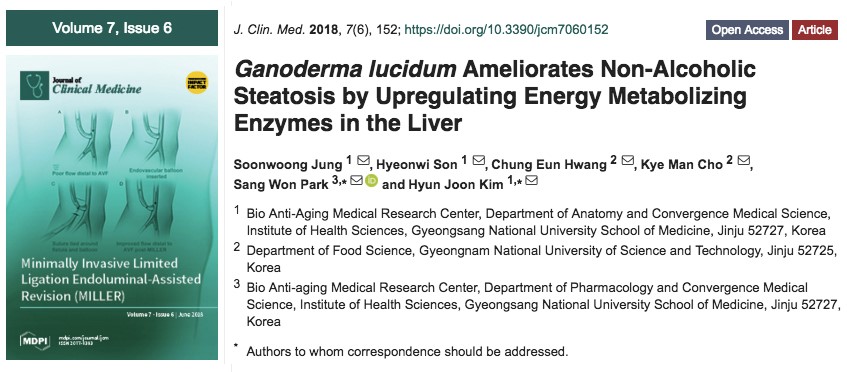
نشرت كلية الطب بجامعة جيونج سانج الوطنية في كوريا الجنوبية بحثًا في مجلة الطب السريري في يونيو 2018 تفيد بذلكغانوديرما لوكيدوم يمكن أن يقلل من تراكم الدهون في الكبد الناجم عن اتباع نظام غذائي عالي الدهون, لكن التجارب على الحيوانات ذات الصلة وجدت أيضًا أن الفئران التي تم تسمينها بنظام غذائي غني بالدهون ستعاني أيضًا من مشاكل أقل خطورة في مستوى السكر في الدم والدهون في الدم بسبب تدخلغانوديرما لوكيدوم.
تم تقسيم الفئران التجريبية إلى أربع مجموعات: النظام الغذائي العادي (اختصار الثاني), النظام الغذائي العادي (اختصار الثاني) + غانوديرما لوكيدوم (جي إل), نظام غذائي عالي الدهون (اتش اف دي), نظام غذائي عالي الدهون (اتش اف دي) + غانوديرما لوكيدوم (جي إل). في تغذية مجموعة النظام الغذائي العادي, الدهون تمثل 6% من إجمالي السعرات الحرارية; في تغذية النظام الغذائي عالي الدهون, الدهون تمثل 45% من إجمالي السعرات الحرارية, الذي كان 7.5 مرات السابقين. الغانوديرما لوكيدوم إن تغذية الفئران هي في الواقع خلاصة الإيثانول من الجسم الثمريغانوديرما لوكيدوم. وقام الباحثون بإطعام الفئران بجرعة 50 ملغم/كغمغانوديرما لوكيدوم مستخلص الإيثانول يوميًا لمدة خمسة أيام في الأسبوع.
بعد ستة عشر أسبوعا (أربعة أشهر) من التجارب, فقد وجد أن اتباع نظام غذائي غني بالدهون على المدى الطويل يمكن أن يضاعف وزن الفئران. حتى لو أكلواغانوديرما لوكيدوم, فمن الصعب منع الميل إلى زيادة الوزن (شكل 1).
However, في ظل اتباع نظام غذائي عالي الدهون, على الرغم من أن الفئران تأكلغانوديرما لوكيدوم والفئران التي لا تأكلغانوديرما لوكيدوم يبدو أن لديهم مستويات مماثلة من السمنة, ستختلف حالتهم الصحية بشكل كبير بسبب الأكل أو عدم الأكلغانوديرما لوكيدوم.
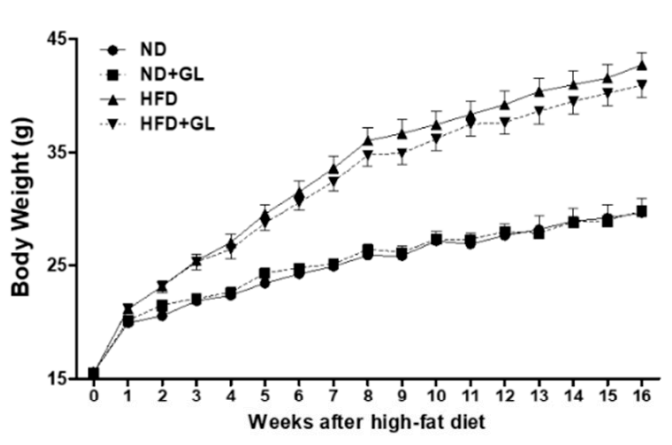
الشكل 1 تأثيرغانوديرما لوكيدوم على وزن الجسم من الفئران التي تغذيها HFD
غانوديرما لوكيدوم يقلل من تراكم الدهون الحشوية في الفئران التي تتغذى على HFD.
شكل 2 هو رسم تخطيطي إحصائي لمظهر ووزن الكبد, الدهون المحيطة بالكلية والدهون البربخية لكل مجموعة من الفئران في نهاية التجربة.
الكبد هو مصنع معالجة المواد الغذائية في الجسم. سوف تتحلل جميع العناصر الغذائية الممتصة من الأمعاء, يتم تصنيعه ومعالجته بواسطة الكبد إلى شكل يمكن استخدامه بواسطة الخلايا, ومن ثم توزيعها في كل مكان من خلال الدورة الدموية. بمجرد وجود فائض في العرض, سيقوم الكبد بتحويل السعرات الحرارية الزائدة إلى دهون (الدهون الثلاثية) وتخزينها لحالات الطوارئ.
كلما تم تخزين المزيد من الدهون, كلما أصبح الكبد أكبر وأثقل. بالطبع, سوف تتراكم الدهون الزائدة أيضًا حول الأعضاء الداخلية الأخرى, والدهون المحيطة بالكلية والدهون البربخية تمثل تراكم الدهون الحشوية الذي لوحظ في التجارب على الحيوانات.
ويمكن رؤيته من الشكل 2 الذي - التيغانوديرما لوكيدوم يمكن أن يقلل بشكل كبير من تراكم الدهون في الكبد والأعضاء الداخلية الأخرى الناجمة عن اتباع نظام غذائي غني بالدهون.
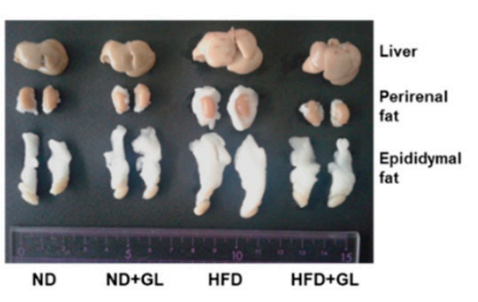
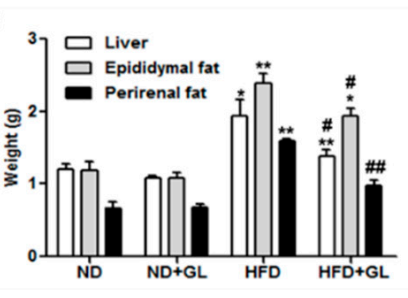
الشكل 2 تأثيرغانوديرما لوكيدوم على الدهون الحشوية في الفئران التي تتغذى على HFD
غانوديرما لوكيدوم يقلل من الكبد الدهني في الفئران التي تتغذى على HFD.
وقام الباحثون أيضًا بتحليل محتوى الدهون في كبد الفئران: تم تلطيخ أقسام أنسجة الكبد لدى الفئران في كل مجموعة بصبغة خاصة, وتتحد قطرات الزيت الموجودة في أنسجة الكبد مع الصبغة وتتحول إلى اللون الأحمر. كما هو مبين في الشكل 3, كان محتوى الدهون في الكبد مختلفًا بشكل كبير في نفس النظام الغذائي عالي الدهون مع أو بدون إضافةغانوديرما لوكيدوم.
تم قياس كمية الدهون الموجودة في أنسجة الكبد لدى الفئران في كل مجموعة في الشكل 4, ويمكن ملاحظة أن الكبد الدهني في مجموعة النظام الغذائي عالي الدهون وصل إلى الدرجة 3 (كان محتوى الدهون أكثر من 66% من وزن الكبد كله, مما يدل على الكبد الدهني الشديد). في نفس الوقت, محتوى الدهون في كبد الفئران التي تتغذى على HFD والتي أكلتغانوديرما لوكيدوم تم تخفيضه بمقدار النصف.
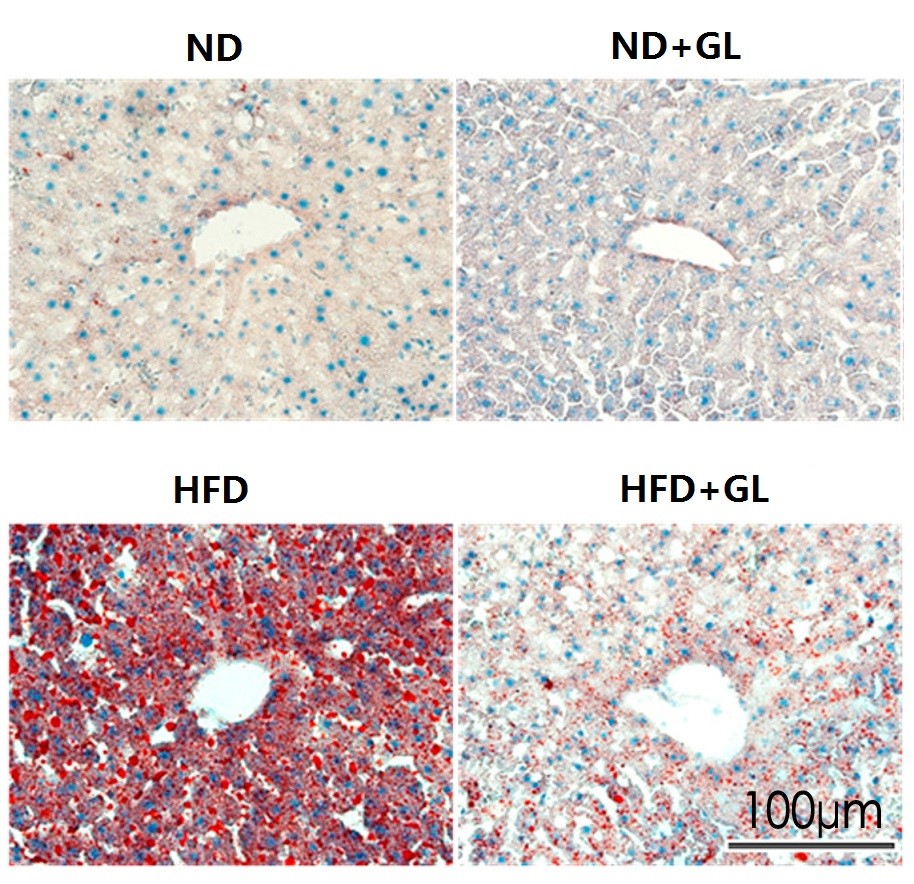
الشكل 3 نتائج تلطيخ الدهون لأقسام أنسجة كبد الفأر
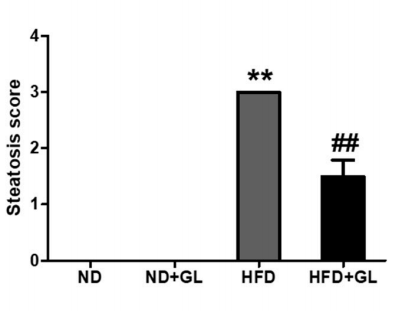
الشكل 4 تأثيرغانوديرما لوكيدوم على تراكم الدهون في الكبد في الفئران التي تتغذى على HFD
[وصف] تم تصنيف شدة الكبد الدهني إلى درجات 0, 1, 2, و 3 حسب نسبة وزن الدهون في وزن الكبد: أقل من 5%, 5-33%, أكثر من 33%-66% وأكثر من 66%, على التوالى. تمثل الأهمية السريرية طبيعية, خفيف, الكبد الدهني المعتدل والشديد.
غانوديرما لوكيدوم يمنع التهاب الكبد في الفئران التي تتغذى على HFD.
تراكم الدهون المفرط سيزيد من الجذور الحرة في الكبد, مما يجعل خلايا الكبد عرضة للالتهاب بسبب الأكسدة, وبالتالي التأثير على وظائف الكبد. However, لن يتطور كل الكبد الدهني إلى مستوى التهاب الكبد. طالما أن خلايا الكبد لم تتضرر بشكل مفرط, ويمكن الحفاظ عليها من خلال "تراكم بسيط للدهون" غير ضار نسبيًا.
ويمكن رؤيته من الشكل 5 أن اتباع نظام غذائي عالي الدهون يمكن أن يضاعف ALT في الدم (جي بي تي), أهم مؤشر لالتهاب الكبد, من المستوى الطبيعي بحوالي 40 ش/ل; لكن, لوغانوديرما لوكيدوم يؤخذ في نفس الوقت, يتم تقليل احتمال الإصابة بالتهاب الكبد إلى حد كبير. بوضوح, غانوديرما لوكيدوم له تأثير وقائي على خلايا الكبد المتسللة إلى الدهون.
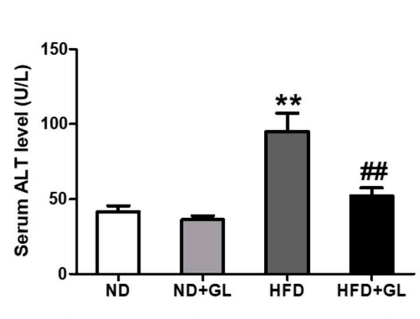
الشكل 5 تأثيرغانوديرما لوكيدوم على مؤشرات التهاب الكبد في الفئران التي تغذيها HFD
غانوديرما لوكيدوم يخفف من مشاكل الدهون في الدم لدى الفئران التي تتغذى على HFD.
عندما يقوم الكبد بتجميع الكثير من الدهون, الدهون في الدم هي أيضا عرضة للتشوهات. وجدت هذه التجربة على الحيوانات في كوريا الجنوبية أن اتباع نظام غذائي غني بالدهون لمدة أربعة أشهر يمكن أن يرفع نسبة الكوليسترول, butغانوديرما لوكيدوم يمكن أن تقلل من خطورة المشكلة (شكل 6).
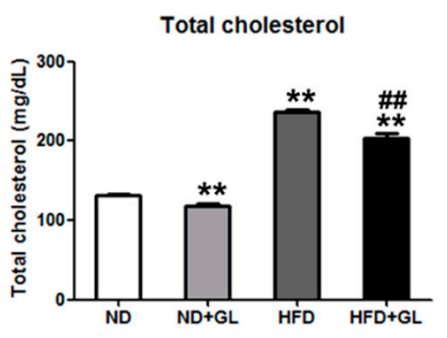
الشكل 6 تأثيرغانوديرما لوكيدوم على الكوليسترول الكلي في الدم في الفئران التي تتغذى على HFD
غانوديرما لوكيدوم يمنع ارتفاع نسبة الجلوكوز في الدم في الفئران التي تتغذى على HFD.
ووجدت التجارب أيضًا أن اتباع نظام غذائي غني بالدهون يمكن أن يؤدي إلى ارتفاع نسبة الجلوكوز في الدم. However, لوغانوديرما لوكيدوم يؤخذ في نفس الوقت, من الواضح أنه يمكن التحكم في مستوى الجلوكوز في الدم عند زيادة طفيفة (شكل 7).
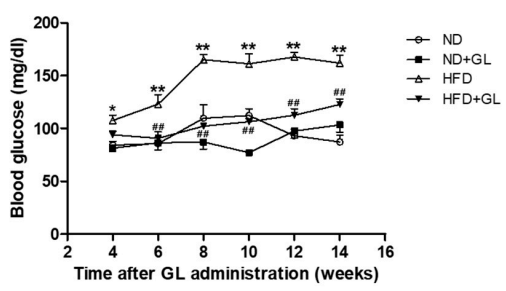
الشكل 7 تأثيرغانوديرما لوكيدوم على نسبة الجلوكوز في الدم في الفئران التي تتغذى على HFD
غانوديرما لوكيدوم يحسن قدرة جسم الفئران التي تتغذى على HFD على تنظيم نسبة السكر في الدم.
كما أجرى الباحثون اختبار تحمل الجلوكوز على الفئران خلال الأسبوع الرابع عشر من التجربة, إنه, في حالة الصيام بعد 16 ساعات الصيام, تم حقن الفئران بكمية عالية من الجلوكوز, ولوحظ تغير نسبة السكر في الدم خلال ساعتين. كلما قل تقلب مستوى الجلوكوز في الدم, كلما كانت قدرة جسم الفأر على تنظيم نسبة الجلوكوز في الدم أفضل.
وقد وجد أن تقلب مستويات السكر في الدم من HFD + كانت مجموعة GL أقل من مجموعة HFD (شكل 8). وهذا يعني ذلكغانوديرما لوكيدوم له تأثير على تحسين تنظيم نسبة الجلوكوز في الدم الناجم عن اتباع نظام غذائي عالي الدهون.
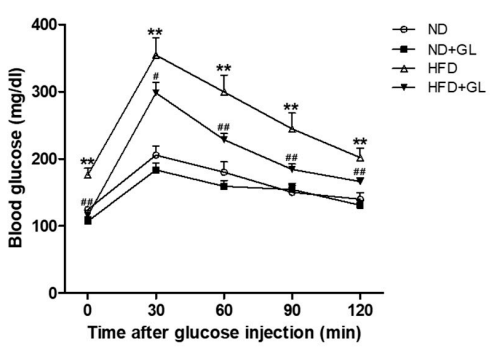
الشكل 8 تأثيرغانوديرما لوكيدومعلى تحمل الجلوكوز في الفئران التي تتغذى على HFD
غانوديرما لوكيدوم يحسن مقاومة الأنسولين في الفئران التي تتغذى على HFD.
أجرى الباحثون أيضًا اختبار تحمل الأنسولين على الفئران: في الأسبوع الرابع عشر من التجربة, تم حقن الفئران الصائمة بالأنسولين, واستخدمت التغيرات في مستويات الجلوكوز في الدم لتحديد مدى حساسية خلايا الفئران للأنسولين.
الأنسولين هو هرمون, الذي يلعب دور المفتاح, السماح للجلوكوز الموجود في طعامنا بالدخول إلى خلايا الجسم من مجرى الدم لإنتاج الطاقة. في ظل الظروف العادية, بعد حقن الأنسولين, سينخفض مستوى الجلوكوز في الدم الأصلي إلى حد ما. لأن المزيد من الجلوكوز في الدم سوف يدخل الخلايا بمساعدة الأنسولين, سينخفض مستوى السكر في الدم بشكل طبيعي.
However, وجدت نتائج التجربة أن اتباع نظام غذائي عالي الدهون على المدى الطويل من شأنه أن يجعل الخلايا تصبح غير حساسة للأنسولين وبالتالي يظل مستوى الجلوكوز في الدم مرتفعا بعد حقن الأنسولين, ولكن في نفس الوقت, تقلب مستوى الجلوكوز في الدم لدى الفئران التي تتغذى على HFD والتي أكلتغانوديرما لوكيدوم كان مشابهًا لتلك الموجودة في الفئران التي تغذيها ND (شكل 9). ومن الواضح أنغانوديرما لوكيدوم له تأثير تحسين مقاومة الأنسولين.
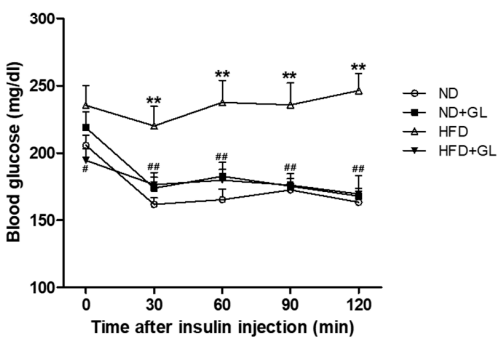
الشكل 9 تأثيرغانوديرما لوكيدوم على مقاومة الأنسولين في الفئران التي تتغذى على HFD
آليةغانوديرما لوكيدوم في تقليل الكبد الدهني
السمنة يمكن أن تسبب مقاومة الأنسولين, ومقاومة الأنسولين لا تسبب ارتفاع السكر في الدم فحسب، بل هي أيضًا العامل الأكثر أهمية الذي يؤدي إلى الكبد الدهني غير الكحولي. لذلك, عندما تقل مقاومة الأنسولين بنسبةغانوديرما لوكيدوم, ومن الطبيعي أن يكون الكبد أقل عرضة لتراكم الدهون.
فضلاً عن ذلك, وأكد الباحثون أيضا أن مستخلص الإيثانولغانوديرما لوكيدوم الجسم المثمر المستخدم في التجارب على الحيوانات لا يمكنه فقط تنظيم نشاط بعض الإنزيمات المشاركة في استقلاب الدهون في الكبد بشكل مباشر فحسب، بل يمنع أيضًا بشكل مباشر تخليق الدهون بواسطة خلايا الكبد., ويتناسب التأثير مع جرعةغانوديرما لوكيدوم. والأهم من ذلك, بعد هذه الجرعات الفعالة منغانوديرما لوكيدوم تمت زراعتها بخلايا الكبد البشرية 24 hours, وكانت الخلايا لا تزال على قيد الحياة وبصحة جيدة.
غانوديرما لوكيدوم له آثار خفض نسبة الجلوكوز في الدم, خفض الدهون وحماية الكبد.
نتائج الأبحاث المذكورة أعلاه لا تخبرنا فقط أن مستخلص الكحول منغانوديرما لوكيدوم الجسم المثمر يمكن أن يقلل من أعراض ارتفاع السكر في الدم, فرط شحميات الدم, والكبد الدهني الناتج عن اتباع نظام غذائي غني بالدهون ولكن يذكرنا أيضًا أنه من الممكن الإصابة بالكبد الدهني دون شرب الكحول.
في الطب, يُشار إلى الكبد الدهني الناجم عن عوامل غير كحولية بشكل جماعي باسم "الكبد الدهني غير الكحولي". على الرغم من وجود عوامل أخرى محتملة (مثل المخدرات), عادات الأكل وعادات نمط الحياة لا تزال هي الأسباب الأكثر شيوعا. فكر في كيفية عمل كبد الاوز, الذي يحبه الشره كثيرًا, مصنوع? إنه نفس الشيء مع الناس!
وفقا للإحصاءات, ما يقرب من ثلث البالغين لديهم أعراض بسيطة (إنه, لا توجد أعراض لالتهاب الكبد) الكبد الدهني غير الكحولي, وحوالي ربعهم سيتطور إلى التهاب الكبد الدهني في غضون خمسة عشر عامًا. حتى أن هناك تقارير تفيد بأن الكبد الدهني غير الكحولي أصبح السبب الرئيسي لمؤشر ALT غير الطبيعي في تايوان (33.6%), يفوق بكثير فيروس التهاب الكبد B (28.5%) وفيروس التهاب الكبد الوبائي سي (13.2%). (انظر المرجع 2 للحصول على التفاصيل)
ومن المفارقات, مع استمرار وكالات الصحة العالمية في مكافحة التهاب الكبد الفيروسي باللقاحات والأدوية, يتزايد انتشار مرض الكبد الدهني الناجم عن تناول الطعام بشكل جيد أو شرب الكثير.
مرض الكبد الدهني (تنكس دهني) يحدث عندما تصل الدهون في الكبد أو تتجاوزها 5% من وزن الكبد. يجب أن يعتمد التشخيص الأولي لمرض الكبد الدهني على الموجات فوق الصوتية في البطن أو التصوير المقطعي المحوسب (ط م). إذا لم تكن قد طورت عادة إجراء الفحوصات الطبية, يمكنك أيضًا الحكم على ما إذا كنت مصابًا بمرض الكبد الدهني من خلال ما إذا كنت تعاني من متلازمات التمثيل الغذائي مثل السمنة المعتدلة, ارتفاع السكر في الدم (يكتب 2 السكري) وفرط شحميات الدم لأن هذه الأعراض أو الأمراض تحدث غالبًا مع مرض الكبد الدهني غير الكحولي (نافلد).
إنه فقط أنه لا توجد أدوية محددة لمرض الكبد الدهني. هذا هو السبب, بعد تشخيص الكبد الدهني, يمكن للطبيب أن يصف لك نظامًا غذائيًا خفيفًا فقط, ممارسة الرياضة وفقدان الوزن بدلا من العلاجات النشطة. However, ليس من السهل تغيير عادات الأكل وعادات المعيشة. معظم الناس عالقون إما في مستنقع «الفشل في ضبط النظام الغذائي وزيادة النشاط البدني» أو في صراع «الفشل في التخلص من دهون الكبد حتى بالتحكم في النظام الغذائي وزيادة النشاط البدني».
ماذا على الأرض يجب أن نفعل? بعد قراءة نتائج أبحاث جامعة جيونج سانج الوطنية في كوريا الجنوبية, نحن نعلم أن هناك سلاحًا سحريًا آخر, إنه, تناول مستخلص الإيثانولغانوديرما لوكيدوم الجسم المثمر.
غانوديرما لوكيدوم, الذي له وظائف حماية الكبد, خفض نسبة السكر في الدم, وخفض الدهون, حقا فعالة من حيث التكلفة; على الرغم من أنه لا يزال غير قادر على فقدان الوزن, يمكن أن يجعلك على الأقل أكثر صحة حتى لو كنت تعاني من السمنة.
[مصدر]
جونغ س, وآخرون. غانوديرما لوكيدوم يخفف من التنكس الدهني غير الكحولي عن طريق تنظيم إنزيمات استقلاب الطاقة في الكبد. J كلين ميد. 2018 يونيو 15;7(6). بيي: E152. دوي: 10.3390/jcm7060152.
[مزيد من القراءة]
من قبيل الصدفة, في وقت مبكر 2017, تقرير "النشاط المضاد لمرض السكرغانوديرما لوكيدوم السكريات F31، الإنزيمات التنظيمية للجلوكوز الكبدي الخاضعة للتنظيم في الفئران المصابة بداء السكري" تم نشرها بشكل مشترك من قبل معهد قوانغدونغ لعلم الأحياء الدقيقة ومركز مقاطعة قوانغدونغ لمكافحة الأمراض والوقاية منها.. بناء على نموذج حيواني من النوع 2 السكري, يستكشف آلية تنظيمغانوديرما لوكيدوم الجسم الثمري للسكريات النشطة على نسبة الجلوكوز في الدم والوقاية والعلاج من التهاب الكبد الناجم عن مرض السكري. وترتبط آلية عمله أيضًا بتنظيم الإنزيمات المشاركة في استقلاب الطاقة في الكبد وتحسين مقاومة الأنسولين. ويصل هذا التقرير وهذا التقرير الكوري الجنوبي إلى نفس الغاية ولكن بوسائل مختلفة. ويمكن للأصدقاء المهتمين أيضًا الرجوع إلى هذا التقرير.
مواد مرجعية حول الكبد الدهني غير الكحولي
1. تنغ تسينغ هوانغ وآخرون. الكبد الدهني غير الكحولي. طب الأسرة والرعاية الطبية الأولية, 2015; 30 (11): 314-319.
2. تشينغ فنغ سويت آل. تشخيص وعلاج مرض الكبد الدهني غير الكحولي. 2015; 30 (11) : 255-260.
3. يينغ تاو وو وآخرون. مقدمة في علاج مرض الكبد الدهني غير الكحولي. المجلة الصيدلانية, 2018; 34 (2) : 27-32.
4. هوي وون ليانغ: يمكن عكس مرض الكبد الدهني ونقول وداعًا للكبد الدهني! الوقاية من أمراض الكبد & موقع مؤسسة أبحاث العلاج.
نهاية
نبذة عن الكاتبة/ م. وو تينغياو
وقد ظل وو تينغ ياو يقدم تقارير عن معلومات الجانوديرما المباشرة منذ ذلك الحين 1999. هي مؤلفة الشفاء بالجانوديرما (نشرت في دار النشر الطبية الشعبية في أبريل 2017).
★ يتم نشر هذه المقالة بموجب التفويض الحصري للمؤلف.
★ لا يمكن إعادة إنتاج الأعمال المذكورة أعلاه, مقتطفة أو مستخدمة بطرق أخرى دون إذن المؤلف.
★ لانتهاكات البيان أعلاه, سوف يتابع المؤلف المسؤوليات القانونية ذات الصلة.
★ تمت كتابة النص الأصلي لهذه المقالة باللغة الصينية بواسطة Wu Tingyao وترجمها إلى الإنجليزية بواسطة Alfred Liu. إذا كان هناك أي اختلاف بين الترجمة (إنجليزي) والأصل (الصينية), يجب أن تسود الصينية الأصلية. إذا كان لدى القراء أي أسئلة, يرجى الاتصال بالمؤلف الأصلي, آنسة. وو تينغياو.



